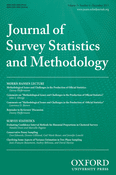-
Views
-
Cite
Cite
Natalie Dean, Marcello Pagano, Evaluating Confidence Interval Methods for Binomial Proportions in Clustered Surveys, Journal of Survey Statistics and Methodology, Volume 3, Issue 4, December 2015, Pages 484–503, https://doi.org/10.1093/jssam/smv024
Close - Share Icon Share
Abstract
In survey settings, a variety of methods are available for constructing confidence intervals for proportions. These methods include the standard Wald method, a class of modified methods that replace the sample size with the survey effective sample size (Wilson, Clopper-Pearson, Jeffreys, and Agresti-Coull), and transformed methods (Logit and Arcsine). We describe these seven methods, two of which have not been previously evaluated in the literature (the modified Jeffreys and Agresti-Coull intervals). For each method, we describe two formulations, one with and one without adjustment for the design degrees of freedom. We suggest a definition of adjusted effective sample size that induces equivalency between different confidence interval expressions. We also expand on an existing framework for truncation that can be used when data appear to be more efficient than a simple random sample or when data have standard error equal to zero. We compare these methods using a simulation study modeled after the 30 × 7 design for immunization surveys. Our results confirmed the importance of adjusting for the design degrees of freedom. As expected, the Wald interval performed very poorly, frequently failing to achieve the nominal coverage level. For similar reasons, we do not recommend the use of the Arcsine interval. When the intracluster correlation coefficient is high and the prevalence, p, is less than 0.10 or greater than 0.90, the Agresti-Coull and Clopper-Pearson intervals perform best. In other settings, the Clopper-Pearson interval is unnecessarily wide. In general, the Logit, Wilson, Jeffreys, and Agresti-Coull intervals perform well, although the Logit interval may be intractable when the standard error is equal to zero.







